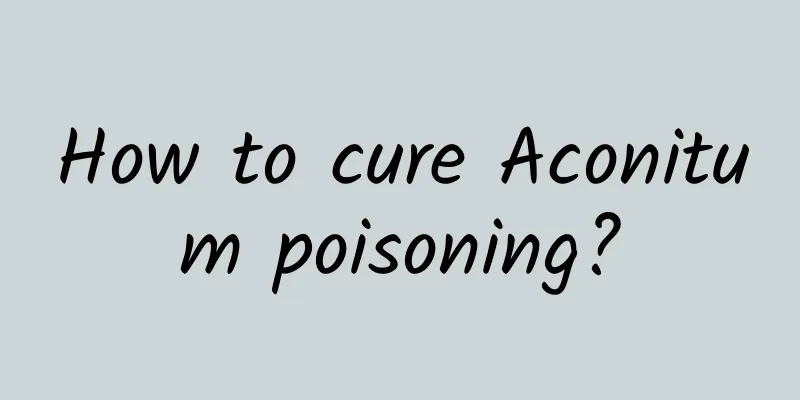How to cure Aconitum poisoning?

|
Aconitum can be used to treat diseases, but improper use can cause poisoning. After Aconitum poisoning, the body will experience symptoms such as vomiting, diarrhea, dizziness, etc., which are very harmful to human health and need to be treated in time. Aconitum poisoning needs to go to the hospital for gastric lavage in time. Never take some emetic drugs at home by yourself, otherwise it will delay the disease and cause serious harm to your health. Aconitum contains highly toxic disilic acid alkaloids: mesoaconitine, hypoaconitine, aconitine, etc. The poisoning mechanism is mainly on the nerves and heart. In the nerves, it is mainly to first excite and then paralyze the sensory nerves and central nervous system. The mechanism of disappearance of warmth, pain, touch and pressure sensation may be that Aconitum directly or indirectly acts on the unmyelinated and thinner nerve fibers, thereby preventing the occurrence and conduction of impulses. The reason may be that aconitine competes with calcium ions for the binding of phospholipids on the membrane, causing changes in the sodium transport channel, preventing the influx of sodium ions necessary for generating action potentials, thereby blocking the conduction of nerve impulses and affecting the binding of pain-related central endogenous neurotransmitters such as serotonin, catecholamines, acetylcholine, endorphins and other carcinogens to corresponding receptors. Therefore, accidental ingestion of Aconitum should be treated immediately, and vomiting, gastric lavage and laxatives should be induced immediately in the early stages. Gastric lavage solution can be potassium permanganate and tannic acid solution. The catharsis agent can be injected into the stomach through a gastric tube after gastric lavage with sodium sulfate or magnesium sulfate. You can also use 2% saline high-level colon irrigation, but if it is medicinal wine, gastric lavage is generally not very meaningful. Give plenty of fluids to promote excretion of toxins. For patients with slow heartbeat and arrhythmia, 1-2 mg of atropine can be injected subcutaneously or intramuscularly. The injection can be repeated every 4-6 hours. For severe cases, 0.5-1 mg of atropine can be added to glucose solution and slowly injected intravenously. For symptomatic treatment, antiarrhythmic drugs (such as lidocaine) can be used for patients whose arrhythmias cannot be corrected after treatment with atropine. If severe arrhythmias occur, such as ventricular tachycardia or ventricular fibrillation, electric shock therapy may be used, and those with low blood pressure may be given pressor drugs. Respiratory depression, heart failure, etc. can be treated with appropriate measures. Pharmacological effects of Aconitum kusnezoffii 1. Aconitum has obvious anti-inflammatory and analgesic effects, and has a cardiotonic effect, but excessive dosage can cause arrhythmia and eventually lead to cardiac depression; 2. Aconitine can cause arrhythmia and hypertension, and can also enhance the toxic effect of citrus aurantium G on the myocardium, and has a significant local anesthetic effect; 3. Aconitum polysaccharide can significantly reduce normal blood sugar; 4. Aconitum injection has anti-cancer effects and can inhibit gastric cancer cells. |
<<: What are the taboos of eating Aconitum carmichaelii?
>>: What should I avoid when taking warming and nourishing Chinese medicine?
Recommend
Good news: mosquitoes are dying of heat in the south; bad news: they're heading north
August 20th is World Mosquito Day . This day is n...
Effects and functions of Northeast Alnus
Nowadays, our living standards are constantly imp...
Exploring the Sharpless Catalogue of Bright Nebulae: A Fantastic Journey Through the Nebulae of the Milky Way
Author | Wang Siliang Review | Zheng Chengzhuo Ed...
You may not know it, but you have eaten the candied haws made from it.
Today we are going to talk about the outdated fru...
The efficacy and function of dragonfly orchid
Dragonfly Orchid is a kind of traditional Chinese...
Why is the meat of mantis shrimp so delicious? It turns out that it is trained through "boxing"!
Review expert: Liang Yujun, Associate Professor, ...
How big is the largest earthquake in human history? What is the limit of earthquakes?
The China Earthquake Networks Center officially d...
The efficacy and function of creeping grass
Many people choose Creeping Jasmine because of it...
The role and efficacy of ivy
Ivy is a very common green vine in daily life. It...
The efficacy and function of water chestnut shell
In fact, the occurrence of many human diseases is...
How can you eat water chestnuts to remove dampness?
Gorgon fruit is a very common Chinese medicine. I...
Can the decoction prescribed by traditional Chinese medicine for medical abortion eliminate the residue?
Sometimes, incomplete abortion may occur after me...
Can eating more "blue foods" such as seafood solve the human food crisis?
Written by: Zhu Hengheng Editor: Wang Xinkai Layo...
Can Panax notoginseng be used to make wine?
Panax notoginseng is also known as Tianqi. It is ...









